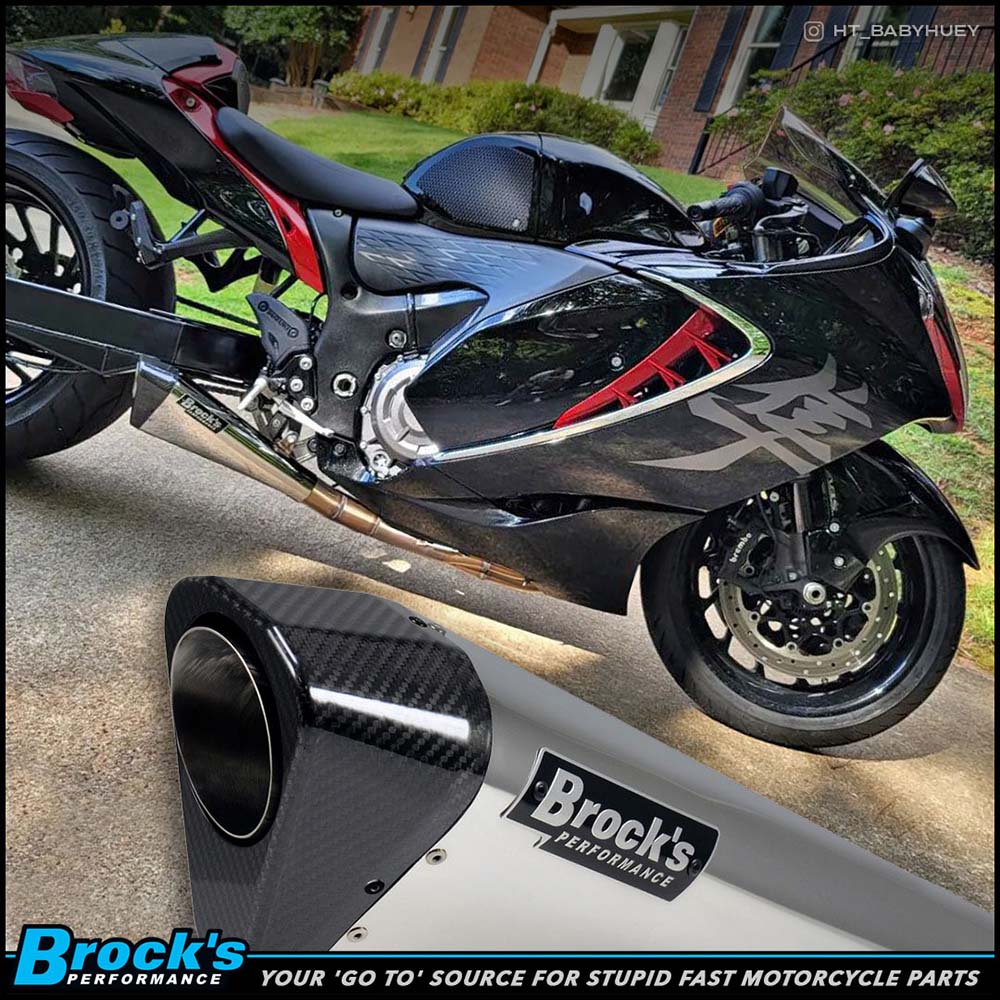If you've just bought a new slip-on exhaust for your motorcycle, you may have questions about tuning. Typically, for a full exhaust system, you need to tune your power commander to ensure that you have the correct ratio of fuel and air for your engine. But what about slip-on exhausts? Do you need to tune your engine for this kind of upgrade?
The answer is generally no—you don't need to tune your power commander for a slip-on motorcycle exhaust. The reason for this is that a slip-on exhaust doesn't significantly alter the fuel and air ratio of your engine, so there's no need for tuning. In this article, we'll dive deeper into exhausts and tuning, including going over the basics of slip-on exhausts and explaining how to know when you need to tune your engine after a motorcycle exhaust upgrade.
Understanding Slip-On Exhausts
What are slip-on exhausts? These aftermarket parts are designed to enhance the performance, sound, and aesthetics of motorcycles. Unlike full exhaust system upgrades, slip-on exhausts replace only the muffler portion of the stock exhaust system. The name "slip-on" stems from the ease with which these components can be installed—they typically slide onto the existing header pipes and are secured in place with clamps or fasteners.
Typically, a slip-on exhaust replaces the stock muffler, allowing riders to achieve a customized look and sound without the complexity of a full exhaust overhaul. This modification is known for its immediate impact on the bike's visual aesthetics and sound profile, making it a popular choice among riders seeking a balance between customization and simplicity.

The Benefits of Slip-On Exhausts
Slip-on exhausts are a popular choice among riders seeking a relatively simple and cost-effective upgrade, as they provide noticeable changes in the motorcycle's exhaust note and can contribute to a modest increase in horsepower. Their installation requires minimal technical expertise, making them accessible to riders who want to personalize their bikes without the complexity associated with full exhaust system replacements.
There are many reasons why you may want to purchase an aftermarket slip-on motorcycle exhaust. In particular, they are a popular modification among motorcycle owners seeking a sound or style upgrade from their OEM parts. slip-on exhausts come in a variety of styles and materials, allowing riders to tailor their choice to both performance preferences and aesthetic considerations. Unlike full-system exhausts that replace the entire exhaust system, slip-on exhausts are designed to be easily installed by replacing only the muffler portion of the exhaust. This results in a more cost-effective upgrade that allows riders to enjoy the perks of aftermarket customization without the complexity and expense associated with a full exhaust system replacement.
Additionally, though they don't offer the same level of performance upgrades as a full exhaust system would, there can be some performance improvements as well. For instance, our Single Penta-Carbon Slip-On System (Polished) Z H2 (20-23) has an 81% weight savings compared to an OEM muffler. This can lead to improved handling and a better overall riding experience.
However, one of the most noticeable advantages of installing an aftermarket slip-on exhaust is the enhanced sound quality it provides. Many motorcycle owners appreciate the deep and resonant tone that aftermarket slip-ons produce, giving their rides a more aggressive and sporty sound profile. This not only adds a touch of personalization to the bike but also contributes to increased visibility on the road, alerting other motorists to the presence of the motorcycle.
Understanding Exhausts and Tuning
Aftermarket exhaust systems play a significant role in enhancing the performance and aesthetics of motorcycles and understanding the relationship between exhaust upgrades and engine tuning is crucial for riders seeking to maximize their benefits. In the case of slip-on exhausts, which typically replace only the muffler portion of the exhaust system, engine tuning is often unnecessary.
The reason lies in the minimal impact on the overall air-fuel mixture and engine dynamics. Slip-on exhausts are designed to work within the parameters of the stock engine settings, ensuring that the motorcycle runs efficiently without requiring adjustments to the fuel injection or ignition timing. This makes slip-on exhaust installations a convenient and hassle-free upgrade for riders who want to experience a change in sound and aesthetics without diving into complex engine tuning processes.
Choosing Between a Slip-On Vs. a Full-System Exhaust Upgrade
There are a few key differences between a slip-on exhaust and a full-system exhaust upgrade. These differences are why tuning is usually necessary in a full system exhaust, but not in a slip-on exhaust. Choosing between them is a decision that depends on a rider's preferences, budget, and desired level of modification.
While slip-ons provide a noticeable change in sound and can contribute to a modest increase in power, they are generally more straightforward and do not require extensive engine tuning. This makes slip-on exhausts an attractive option for riders seeking a hassle-free upgrade that adds a touch of personalization to their bike without breaking the bank.
In contrast, full exhaust system upgrades involve replacing the entire exhaust system, including the header pipes. This comprehensive modification offers greater potential for performance gains, as it improves exhaust flow and reduces backpressure more significantly than slip-ons. The result is often a more substantial increase in horsepower and torque.
However, full system upgrades typically come with a higher price tag and may require additional investments in engine tuning to optimize the air-fuel mixture and ignition timing. Riders considering a full exhaust system upgrade should be prepared for a more involved installation process and a greater commitment to tuning to unlock the full performance potential of their motorcycle. Ultimately, the choice between slip-on exhausts and full exhaust system upgrades depends on the rider's priorities, budget, and willingness to engage in more extensive modifications.
What Is Tuning?
Motorcycle tuning refers to the process of adjusting and optimizing the engine's performance parameters to achieve the best possible balance between the engine's fuel-to-air ratio. This process involves modifying the motorcycle's electronic control unit (ECU) settings, which govern variables like fuel injection timing, air-fuel mixture, and ignition timing. The goal of tuning is to enhance the motorcycle's overall performance, ensuring it operates at its peak efficiency while adapting to modifications or upgrades, such as the installation of aftermarket components like exhaust systems or air filters.
Fuel injection systems have become the standard in modern motorcycles, replacing traditional carburetors to enhance efficiency and performance. Unlike carburetors, which rely on a mixture of air and fuel delivered through mechanical means, fuel injection systems utilize electronic sensors and injectors to precisely regulate the amount of fuel sprayed into the combustion chamber. This electronic precision allows for better control over the air-fuel mixture, optimizing combustion and improving overall engine performance. The fuel injection system ensures that the engine receives the right amount of fuel under varying riding conditions, resulting in improved fuel efficiency, reduced emissions, and better throttle response.
A full exhaust system upgrade typically improves exhaust flow, potentially allowing more air to flow through. This change can lead to a mismatch between the amount of air and fuel being delivered to the engine, affecting combustion efficiency. To counteract these effects and ensure optimal performance, adjustments to the fuel injection system, often facilitated by devices like the power commander, may be necessary. Proper tuning then becomes crucial to restoring balance and maximizing the benefits of the slip-on exhaust without compromising overall engine health and efficiency.

Knowing When To Tune Your Power Commander After an Exhaust Upgrade
Knowing when to tune your motorcycle after an exhaust upgrade is crucial to ensure that your bike operates optimally and takes full advantage of the performance enhancements introduced by the new exhaust system. The need for tuning is dictated by the extent of the exhaust modification. If you've opted for a simple slip-on exhaust, which replaces only the muffler, tuning may not be an immediate requirement. Slip-ons generally work within the stock parameters of the bike's engine, and the change in backpressure is minimal. However, if you start noticing issues like popping during deceleration or a loss in performance, it could be an indication that some adjustments in the fuel delivery or ignition timing might be beneficial, warranting a tune-up.
On the other hand, if you've undertaken a more comprehensive full exhaust system upgrade, tuning likely becomes necessary. The increased exhaust flow and potential changes in backpressure significantly impact the air-fuel mixture and engine dynamics. Without proper tuning, your motorcycle might experience issues such as running too lean or too rich, leading to poor fuel efficiency, reduced power, and potential damage to the engine over time. To get the most out of a full system upgrade, consider engaging in professional engine tuning or using a power commander to adjust your motorcycle's settings and ensure that the modifications harmonize seamlessly with the engine's performance requirements.
Other Adjustments for Optimal Performance
While a slip-on exhaust can enhance motorcycle performance, riders should also consider additional modifications for a comprehensive and well-rounded setup. An upgrade such as high-flow air filters can complement the effects of an aftermarket exhaust, providing better improvement in power and efficiency.
If you're pursuing optimal performance through modifications, it's crucial not to overlook the significance of regular maintenance and professional service. Modifications can put additional stress on various motorcycle components, and neglecting routine maintenance can lead to premature wear and decreased reliability. Proper installation and maintenance of your motorcycle's various components not only ensures the longevity of the motorcycle but also safeguards the investment you made in performance upgrades. Riders should adhere to the manufacturer's maintenance schedule and be proactive in addressing issues to sustain the benefits of their modifications over the long term.
However, particularly with full exhaust systems and tuning, it may be best to utilize professional services. While many riders may enjoy tinkering with their bikes, complex tuning requirements, especially in the case of extensive modifications, may necessitate professional expertise. Enlisting the services of a skilled professional can not only save time but also mitigate the risk of causing unintentional damage to the engine. For riders venturing into more intricate modifications or facing challenges in achieving the desired performance, consulting with a professional ensures a tailored approach to meet specific performance goals.
Exploring Our Selection of Motorcycle Exhausts
Overall, thanks to slip-on exhausts' simple and functional design, tuning is generally not required after making this upgrade to your motorcycle. However, when it comes to full system exhausts, it's often necessary to make adjustments, as the extensive modifications of this upgrade require tuning.
Depending on your performance goals, budget, and other factors, you may find that you prefer the simplicity of slip-on exhausts or the robust features of a full system exhaust upgrade. We offer a wide range of both slip-on exhausts as well as full exhaust systems. Our ultra-light stainless exhaust full exhaust systems offer unparalleled benefits that cannot be found in slip-on exhausts.
Check out our full exhaust selection to find the option that's right for you. We also offer our technical expertise with every exhaust system purchase, so if you have questions about your exhaust system or tuning, ask for support from our experienced team.
